“Seeing this gradation and diversity of structure in one small, intimately related group of birds, one might really fancy that from an original paucity of birds in this archipelago, one species had been taken and modified for different ends.” – Charles Darwin Voyage of the Beagle (1839)
By Eilene Lyon
Just after completing my environmental biology degree in December 2007, we took an appropriate trip to Ecuador, including a 4-day excursion in the Galapagos Islands. My “mentor,” Charles Darwin, spent five weeks exploring the islands in the fall of 1835, exactly 300 years after their discovery.
Darwin was on a 5-year circumnavigation of the southern hemisphere on board the Beagle. Though only in his early 20s during the journey, his 1839 book about it reveals his intelligent and inquisitive mind. He didn’t publish The Origin of Species for another 20 years, but he was clearly piecing together a theory on this trip. He took every opportunity to explore the lands along the way – especially since he never got over his vulnerability to seasickness.
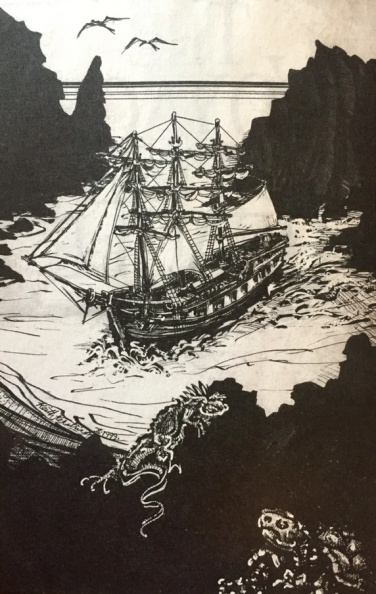
HMS Beagle at the Galapagos Islands by Keith R. W. Kersting of Hawai’i from Voyage of the Beagle (2000)
From these maps, you can see that the names of the islands were changed since Darwin’s day. The endemic wildlife has suffered decline since he visited, particularly the tortoise populations. I thought I’d accompany my photos with some of the great scientist’s insights and observations.
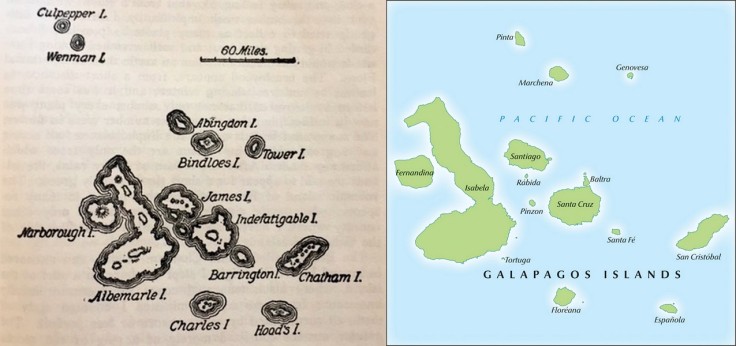
Despite predation by humans in earlier times, the wildlife today is completely unafraid of visitors. Even birds do not fly off at your approach. It’s as if they don’t even see you – almost conjuring a sense of invisibility. The only carnivorous bird on the island is the Galapagos hawk. Sea lions do not hunt on shore. Generally, the animals just die of old age.
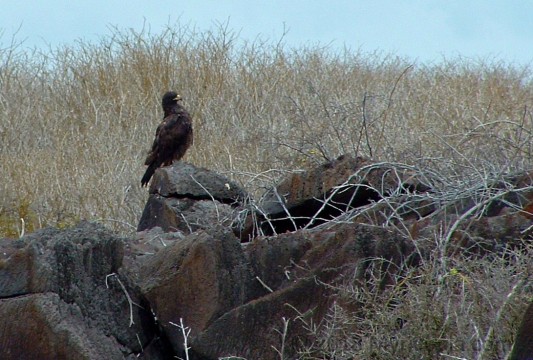
Galapagos hawk

Sea lion and iguana carcasses, most likely natural deaths.
“The remaining land-birds form a most singular group of finches, related to each other in the structure of their beaks, short tails, form of body and plumage.”
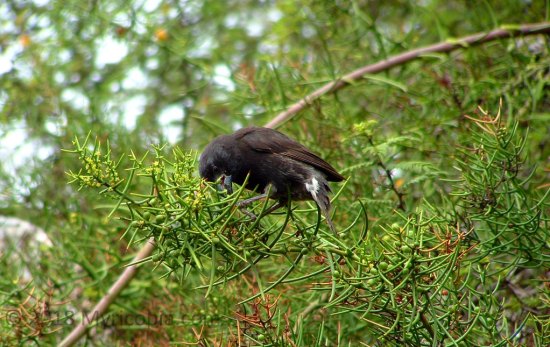
A large-beaked finch eating berries
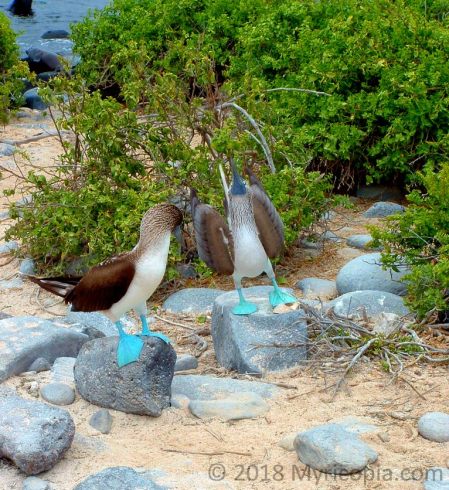
Blue-footed boobies doing a mating ritual

A boobie couple with their chick in the “nest.” You really need to watch your step!
“Nothing could be less inviting than the first appearance. A broken field of black basaltic lava, thrown into the most rugged waves, and crossed by great fissures, is everywhere covered by stunted, sun-burnt brush-wood, which shows little signs of life.”
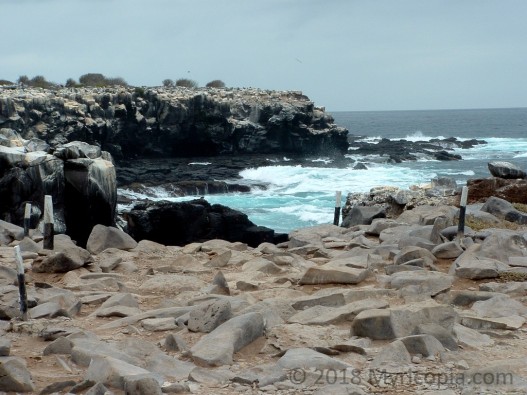
Barren, basaltic coast of Española Island

Unique vegetation on South Plaza Island, including prickly pear trees.
“The absence of the frog family in the oceanic islands is the more remarkable, when contrasted with the case of lizards, which swarm on most of the smallest islands. May this difference not be caused, by the greater facility with which the eggs of lizards, protected by calcareous shells, might be transported through salt-water, than could the slimy spawn of frogs?”

Marine iguana
“The rocks on the coast abounded with great black lizards, between three and four feet long; and on the hills, an ugly yellowish-brown species was equally common.”

Land iguana
“As I was walking along I met two large tortoises, each of which must have weighed at least two hundred pounds: one was eating a piece of cactus, and as I approached, it stared at me and slowly walked away; the other gave a deep hiss, and drew in its head.”
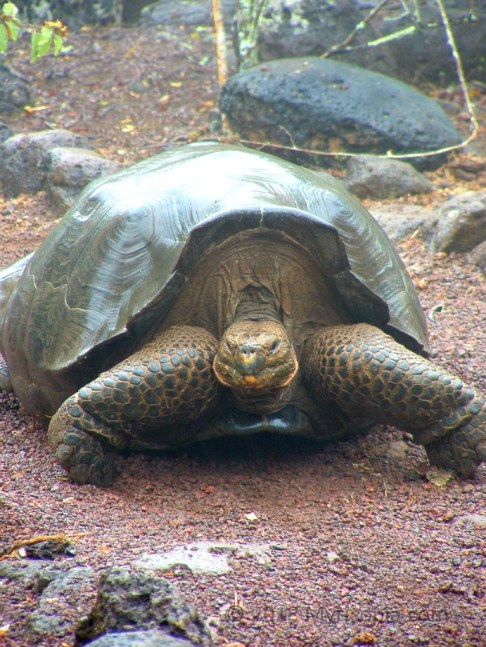
“While staying in this upper region, we lived entirely upon tortoise-meat: the breast-plate roasted (as the Gauchos do carne con cuero), with the flesh on it, is very good; and the young tortoises make excellent soup; but otherwise the meat to my taste is indifferent.”
“The old males are the largest, the females rarely growing to so great a size: the male can readily be distinguished from the female by the greater length of its tail.”

Lonesome George (d. 2012) in his enclosure at the Darwin Research Center. He was the last of his species of tortoise.
“Considering the wandering habits of the gulls, I was surprised to find that the species inhabiting these islands is peculiar, but allied to one from the southern parts of South America.”

Swallow-tailed gulls
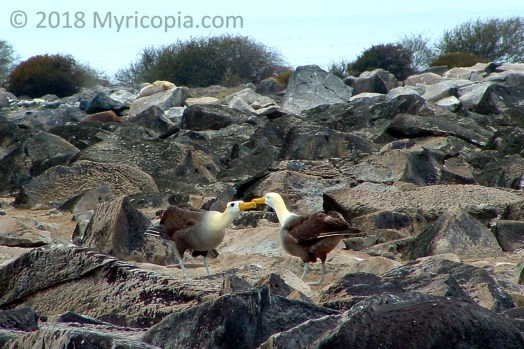
Mating dance of the waved albatross
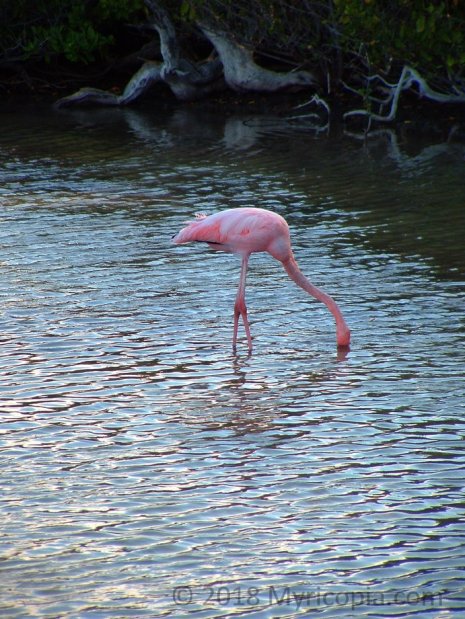
Uncooperative flamingo – refused to lift its head even once!
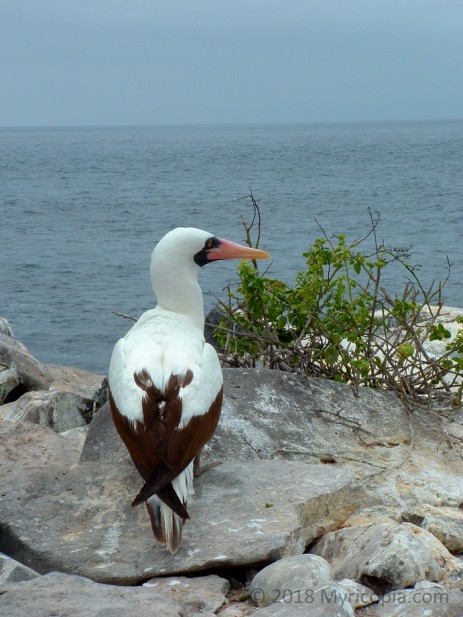
Masked boobie
Darwin didn’t mention sea lions in his chapter about the Galapagos. But they are a delight to tourists. We were told not to approach them, but they apparently weren’t given the same message.



A Galapagos sunrise
Source of all quotations:
Darwin, Charles. 2000. The Voyage of the Beagle with an Introduction by H. James Birx. Great Minds Series, Prometheus Books, Amherst, New York.

I just heard the story of Lonesome George on a history podcast and how the goat infestation on the Galapagos was handled. It gave me hope that environments can recover from humans’ destruction.
LikeLiked by 1 person
Sometimes we humans do manage to reverse a bad situation we’ve caused. Better not to mess up in the first place, though. 🙂
LikeLike
We had the holiday of a lifetime in Galapagos in 1999, but I wouldn’t go back. I’ve had my turn! Great pictures.
LikeLiked by 1 person
I agree. It was great to visit, but once is plenty. As long as there are new places to explore in this world, I rarely return anywhere.
LikeLiked by 1 person
It’s nice to see a place where wildlife is allowed to behave like wildlife.
LikeLiked by 1 person
I’d say it’s magical, but it’s actually natural!
LikeLiked by 1 person
It’s beautiful is what it is.
LikeLiked by 1 person
Enjoyed the melding of Darwin’s quotes with your pictures. Hard to imagine Darwin eating tortoise, but then again, why not? Your nearly last photo of the sea lion made it look like that guy had seen a camera or two; nice pose.
LikeLiked by 2 people
Thanks! They are natural paparazzi posers, for sure!
LikeLiked by 2 people
Me either. Every time I come across someone feasting on turtle soup, I take pause. A delicacy, and that alone should speak volumes.
LikeLiked by 2 people
PS In a book. Thank God I don’t know anyone who has that on their menu.
LikeLiked by 1 person
I’ve never come across it on a menu. I think mock turtle soup shows up occasionally.
LikeLiked by 1 person
Mock…let’s hear it for that.
LikeLiked by 1 person
I am fascinated by Darwin and hope to get to the Galapagos one day. When he reached Australia (he was keen to go home by then) he travelled into the Blue Mountains and ate a platypus. Apparently he tried to eat as many animals as he could, something which he later regretted. Love your post.
LikeLiked by 1 person
I would, too! Voyage of the Beagle is quite an entertaining read, actually. More so than Origin of Species.
LikeLike
What an amazing place.
LikeLiked by 1 person
Makes one wonder what the world would be like if we were all vegetarians.
LikeLiked by 1 person
That’s an interesting thought!
LikeLiked by 1 person
Eileen…these pictures are so amazing. I actually stole a tortoise for my foto file being head over heels over turtles. They’re all over my house.
I always am in awe of your intelligence. I’m such an urban writer having only self-taught education. I couldn’t write the way you do with an Uzi to my head. Most awe-inspiring. Truly. Susannah
LikeLiked by 1 person
Self-taught is probably the best kind of learning there is. It means you’re motivated and curious about the world. Thanks for the kind words.
LikeLiked by 1 person
No, thank you for such a wonderful piece. 🙂
LikeLiked by 1 person
This is one of my favorites.
LikeLike
I’m a quasi vegetarian. I only eat salmon and they too might be swimming upstream for good. 🙂
LikeLiked by 1 person
I wish I could say the same. I remain omnivorous.
LikeLiked by 1 person
Moo
LikeLike
LOL. Guilty as charged.
LikeLike
Fascinating and magical. Hope I get to visit these treasures someday …. and I see we have common visitors (Sorryless and Susannah)
LikeLiked by 1 person
Thanks for stopping by and reading! The islands are fascinating, indeed. I only got a small taste.
LikeLike
So interesting. Love all the animals and birds you feature in this post. Just look at this smiling sea lion. most of all I like how you ended with a sunset. Seriously, reminds me that its time to rest…
LikeLiked by 1 person
Nature is really the star at the Galapagos!
LikeLiked by 1 person
Just spotted your blog via Backyard Bio. Good stuff, and anazing timing … I’ll be back…. earlier today the family talked about a group visit to Machu and the Galapogos. (We have a travel biz.) I also sell outdoor photography, ie recent shots from Sedona at: https://www.radfordpictures.com/Destinations/Southwest-USA
LikeLiked by 1 person
Sounds like a great trip. We’re thinking of doing Peru sometime in the not-too-distant future.
LikeLike